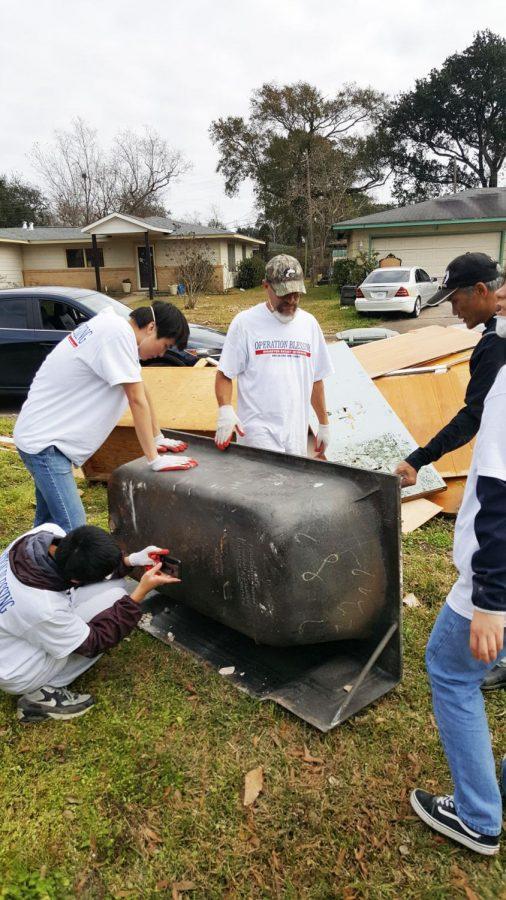Group of WU students spends last week of break helping with relief in Texas
January 21, 2018
While many students were spending their final week of winter break working, relaxing or preparing for the first week of classes, one group of Washburn students spent time helping people in need.
Nineteen Washburn students finished their break with a trip to east Texas to help with the continuing relief efforts from Hurricane Harvey from Jan. 8 to Jan. 14.
Various organizations and groups on campus were involved in the planning, promoting, funding and completion of the project. Craig Freerksen, the director of Christian Challenge at Washburn, was one of the organizers of the project.
“It was [the] Leadership Institute, [Learning in the Community] office, Bonner leaders, I believe there was some WSGA participation with this too,” Freerksen said. “In the administration of the university, there was coordination and organization through them and with them as we were trying to establish an institutional response from Washburn to the hurricane, how we were going to help.”
A lot of the coordination came with the help of a Washburn alumnus Nick Woolery, who works in the city manager’s office in Baytown, Texas. Woolery is no stranger to disaster relief. When he was a student, Woolery took relief trips with Washburn to Greensburg, Kan. after the tornado that devastated the town, and to Louisiana after Hurricane Katrina.
Shortly after Hurricane Harvey hit Texas, Washburn began looking for ways to help the affected areas. The administration worked with the alumni association to let its members know of ways to support the relief effort, especially monetarily. The alumni were given two options: either give directly to Baytown through Washburn or give to the Red Cross.
“We kind of adopted Baytown because Nick was there, because of the impact he had at Washburn,” Freerksen said. “We found someone we could connect with personally.”
The next step in the relief process was to figure out the physical response, or the sending of people to the area. It was decided that there would be two trips taken, the one during the winter break and another coming up during spring break.
Although the winter trip was coordinated partially by Freerksen, he said it was really the work of three students, Mackenzie Moore, Shyla Mason and Hannah Fairchild.
“It was a cooperative effort,” Freerksen said. “We had students from all over campus as part of the trip, including four international students. We were just thrilled to have them.”
The relief effort itself had a few different aspects to it. The Washburn team worked primarily with two different organizations. Some of the students worked with Habitat for Humanity which had two projects: a new construction that started after the hurricane and rebuilding of a house that started before the hurricane.
“The house was beyond the drywall stage and was onto trim and other work,” Freerksen said. “It had about five feet of water in it for five days so it had tremendous work to be done.”
Another organization that Washburn worked with was Operation Blessing. That group’s main purpose was to go into houses and take out things like drywall, tile or anything else that was heavily damaged by water.
Ryan McIntosh, a junior computer science major, was part of that team. McIntosh said one of the most memorable experiences was removing something from one of the houses.
“[The homeowner] had a bathtub from 1957, made out of cast iron,” McIntosh said. “We had five or six guys that had to carry it out of his house.”
Another memorable moment for McIntosh happened while they were destroying tile in a house with sledgehammers. He was about ready to smash the last piece of tile in the kitchen when a fellow team member from Washburn stopped him.
“She takes the tile and writes Kitchen 2018 on it and has all of us sign it,” McIntosh said. “Then we gave it to the homeowner.
The team that worked with Operation Blessing was able to finish work on three houses that would then be moved onto the next step of the process of recovery according to Freerksen.
On the final day, the team was able to help distribute furniture to people who lost everything in the hurricane. Trucks lined up and people would fill out a piece of paper with the things they needed and it was given to them. The furniture was donated from a hotel in another state.
Fortunately, much of the cost of the trip was provided by different organizations and donors, althought there was some cost for the students. Each student had to pay $100 to help cover some of the expenses. Freerksen said that the fact these students had to pay something meant that they were truly invested.
“For a student to say ‘I’m going to spend $100 and spend a week of my break to go and work really hard for five days, 15 hours away’ that means you have students that understand the need to add value to people,” Freerksen said.



